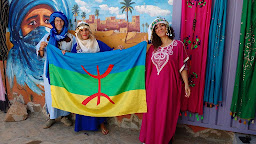The Berbers
The Berbers can be considered the original people of the country. It is not easy to calculate from when they are here, although there are several dates that express their antiquity: some cave paintings in neighboring Algeria are from at least 8,000 years ago and the XXII dynasty of Egypt, from the year 935 BC, was Berber. Even today they form 35-40% of Moroccan society, according to some estimates, and retain much of their traditions, although in the cities they have merged with the Arabs. One of the cultural aspects that they preserve is their language, of which there are three dialects: Amazigh, Chleuh, and Rifeño. Their natural habitat was the mountains and the desert, hence their fame as nomads, although not all were dedicated to transhumance. Although they are predominantly brown in skin and hair, as is the case in North Africa, Berbers with blonde hair and lighter eyes can still be found today, which are a reminder of the mixture they experienced with the invasions of European vandals, in the centuries V and VI.
The Arabs
Arabs formed another specific subculture in Morocco. This subculture invaded Morocco in the 7th and 11th centuries and from this time a new period in the history of Morocco started. Their conquest was met with fierce resistance from the Berber tribes. The Arabs eventually succeeded in taking over Morocco and forcing the Berbers to adopt the Arab culture and Muslim religion. The Arabs represent about 40% of the Moroccan population and live mainly in the northern regions of Morocco. One of the main characteristics of Arab culture in Morocco is their customs, language, music, religion, food, and dress.









